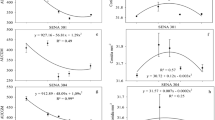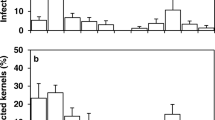Abstract
Wheat-spikes inoculated withN. indica at the boot-leaf stage produced secondary sporidia when later incubated (intact/detached) under moist conditions in the laboratory. Sporidia were also released from inoculated spikes in the field where sporidial release exhibited diurnal periodicity. More sporidia were trapped between 5–6 o'clock than during the later parts of the day but no sporidia were trapped between 14–18 o'clock. However, they could be trapped at any time of the day from the detached spikes incubated under moist conditions in the laboratory. Sporidia trapped in different experiments were invariably of the allantoid type and they proved viable and infective. Maximum sporidia developed on the outer glumes of florets, and this observation was supported by scanning electron microcope studies. Sporidia developed at 15 and 20°C but not at 30°C. These findings indicated that repeated cycles of sporidial production in spikes provided more inoculum than expected from soil-borne teliospores ofN. indica.
Similar content being viewed by others
References
Bedi K S, Sikka H R and Mundkur B B 1949 Transmission of wheat bunt due toNeovossia indica (Mitra) Mundkur. Indian Phytopath. 2, 20–26.
Chona B L, Munjal R L and Adlakha R L 1961 A method for screening wheat plants for resistance toNeovossia indica. Indian Phytopath. 14, 99–101.
Dhaliwal H S, Randhawa A S, Karam Chand and Dalip Singh 1983 Primary infection and further development of Karnal bunt of wheat. Ind. J. agric. Sci. 53, 239–244.
Holton C S 1949 Observations onNeovossia indica. Indian Phytopathol. 2, 1–5.
Krishna A and Singh R A 1982 Effect of physical factors and chemicals on the teliospore germination ofNeovossia indica. Indian Phytopathol. 35, 448–455.
Mathur S C and Ram S 1963 Longevity of chlamydospores ofNeovossia indica (Mitra) Mundkur. Sci. and Cult. 29, 411–412.
Mitra M 1931 A new bunt of wheat in India. Ann. Appl. Biol., 18, 178–179.
Mitra M 1935 Stinking smut (bunt) of wheat with special reference toTilletia indica. Mitra. Indian J. Agric. Sci., 5, 51–74.
Mitra M 1937 Studies on the stinking smut or bunt of wheat in India. Indian J. Agric. Sci. 7, 469–478.
Mundkur B B 1943 Karnal bunt, an air-borne disease. Curr. Sci. 12, 230–231.
Warham E J 1986 Karnal bunt disease of wheat: A literature review. Tropical Pest Management 32, 229–242.
Warham E J 1987 Studies on Karnal Bunt Disease of Wheat. Ph.D. Thesis submitted to University of Wales, UK.
Author information
Authors and Affiliations
Rights and permissions
About this article
Cite this article
Bains, S.S., Dhaliwal, H.S. Release of secondary sporidia ofNeovossia indica from inoculated wheat spikes. Plant Soil 115, 83–87 (1989). https://doi.org/10.1007/BF02220697
Received:
Revised:
Issue Date:
DOI: https://doi.org/10.1007/BF02220697




